By: Conor Peterson
Somewhere, buried on an old hard drive, I’ve got a video that I recorded back in 2011. The scene is a Meow Wolf meeting. We’re in the thick of producing a huge, time-and-space defying sailing vessel. The warehouse is stuffed to the gills with art supplies, props, lumber and people. A dozen young adults are seated around a lead artist, who is explaining that we need to solder together A LOT of custom lighting boards for the gallery ceiling, and we need them pronto. Work commences Friday and will run through the weekend… who wants to help? And about six hands shoot up.
I often think about that moment. Soldering electronics is skilled technical work. What kind of person blindly commits their weekend to assemble circuit boards? Anyone laser-focused on a vision, for one. But also, the arts have a tendency to draw the curious into specialized gardens of knowledge before they’ve even realized it. Combine that with the power of collaboration to assuage the difficult, and such an activity begins to sound like fun. Later, I would go on to teach computer science to art majors, and cultivating this dynamic became an important tool for unlocking the subject matter in my classroom.
In hindsight I also find it remarkable that among these artists, nobody needed to be convinced that combining sculptural installation with technology was a bright idea. The collision between the two was pleasantly reciprocal; an equal number of artists playing with technology were joined by trained technologists eager to create something tangible. The merry makers at Meow Wolf simply regarded all the electronics as another material with which to build. Nail boards together, stack adobe bricks, connect your software to my software with OSC, and together we bring more color into the world.
Having now worked in this domain for years I sometimes lose sight of the fact that this sort of collaboration-first, tech-as-art-material, code-is-humanities approach is still a niche within education. This is puzzling because there are significant advantages to approaching CS from the standpoint of artmaking, especially when the aim is to foster diversity. This year at CSTA I will share more about how we integrate technology into the production of art at Meow Wolf, because while the company has metamorphosed since those larval days in the warehouse, the spirit of collaboration and the thrill of making technology get up and dance is as strong for us as ever. And somewhere along the way, I hope, you will glimpse my own preferred excuse for practicing all this in the first place: the sheer joy of pursuing one’s vision, no matter how wild and weird. See you all soon!
Click here to register and learn more about Conor and the CSTA Annual Conference!
About the Author

Conor Peterson was born in the Seattle area in the early eighties and spent his teenage years training as a computer programmer. Deciding to pursue his love of culture and the arts, he earned an MFA in the Experimental Art and Technology program at the University of New Mexico, where he produced artwork combining sound, embedded electronics, and sculpture. In 2010 he began to volunteer his technical skills to the Meow Wolf art collective, developing interactive elements for The Due Return.
In the years that followed he taught a variety of courses that sought to render technology more accessible to artists, first as a visiting artist at UNM, and ultimately as a visiting professor at Smith and Hampshire colleges, where his syllabi emphasized interdisciplinary studies and shop fabrication within the digital arts.
In 2017 Conor returned to New Mexico to rejoin Meow Wolf. As a Technical Director he contributed to the exhibitions in Las Vegas, Denver and Dallas. Presently he serves as a Creative Engineer within the newly formed Research and Development team, where he works to harness experimental interactive technologies for upcoming exhibits.
In his spare time, Conor enjoys parenting, trail running, gardening, analog photography, and amateur radio.

